|
|
|
Sort Order |
|
|
|
Items / Page
|
|
|
|
|
|
|
| Srl | Item |
| 1 |
ID:
124983
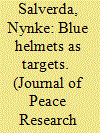

|
|
|
|
|
| Publication |
2013.
|
| Summary/Abstract |
A majority of UN peacekeeping operations deployed to civil wars face violent attacks by rebel groups. To date, the academic study of this type of violence has been very limited. This article is a first attempt to fill this gap. In particular, I aim to examine why rebel groups fight against peacekeepers in some cases, while not in others. I argue that since peacekeepers are mostly impartial but not neutral, they become an actor in a conflict and tend to protect the weaker side from total defeat. This implies that on the one hand, relatively weaker rebels will seek protection from the government by peacekeepers. On the other hand, relatively stronger rebels will challenge the peacekeepers in order to restrict their behavior and/or make them withdraw. If stronger rebels are successful in targeting the peacekeepers and the peacekeepers withdraw or alter their behavior, a victory for these rebel groups should become easier. Using novel data on violence against UN peacekeepers, I find that indeed, stronger rebel groups are more likely to fight against peacekeepers.
|
|
|
|
|
|
|
|
|
|
|
|
|
|
|
|
| 2 |
ID:
124976


|
|
|
|
|
| Publication |
2013.
|
| Summary/Abstract |
Existing studies of intergovernmental organizations (IGOs) and militarized conflict focus on dyadic counts of shared IGO membership. However, dyadic approaches are inconsistent with the basic properties of IGOs. Because IGOs are multilateral organizations, shared membership necessarily involves ties to third parties. This article employs network analytics to develop a novel explanation of how third-party IGO ties reduce militarized conflict. The analysis first examines the 'structural similarity' of states, defined by the extent to which states share similar patterns of IGO membership with relevant third parties. High levels of structural similarity indicate that states interact with a common set of IGO collaborators. The analysis then shows that micro-level changes in IGO membership effect changes in structural similarity, leading to the macro-level phenomenon of 'network convergence,' wherein states increasingly collaborate with the same third parties over time. Substantively, convergence results in increased overlap and integration between states' respective local networks of IGO partners. Because network convergence is costly, involving a combination of IGO-based accession, sovereignty, and alignment costs, it is unlikely to be pursued by purely exploitative state types. Consequently, convergence provides cooperative types with a mechanism for signaling a preference for cooperation over conflict. These credible signals in turn establish mutual trust among cooperators and effectively reduce the risk of militarized conflict. Extensive empirical analysis shows that, in fact, network convergence strongly correlates with a decline in militarized dispute initiations. The more that states collaborate with one another's IGO partners, the less likely they are to fight.
|
|
|
|
|
|
|
|
|
|
|
|
|
|
|
|
| 3 |
ID:
124980
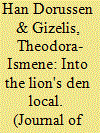

|
|
|
|
|
| Publication |
2013.
|
| Summary/Abstract |
Multidimensional peacekeeping has drawn the United Nations (UN) into state-building, and missions have taken on significant responsibilities for good governance. Since it aims at transforming states from fragile post-conflict situations into inclusive, well-governed societies, multidimensional peacekeeping is more complex and arguably also more contentious than traditional peacekeeping. Multidimensional peacekeeping affects the balance of power between the government and rebels and provides them with opportunities for rent-seeking. Although the potential gains are obvious, the process is bound to lead to uncertainty and controversy. Whereas the international community mainly appreciates the opportunity of comprehensive peacekeeping to create value, local actors may be more concerned with opportunities for claiming value. What will be the responses of local actors to peacekeeping given the likely impact on the distribution of power between rebels and governments and their uneven opportunities to benefit from collaborating? Using event data for post-Cold War UN peacekeeping missions in Africa, the analysis considers when peacekeeping elicits cooperation rather than conflict, focusing on (a) the authorities involved in the event, (b) the policies implemented, and (c) the role of the peacekeepers. Key findings are that government authorities are more likely to respond cooperatively to peacekeeping actions, while rebels are more likely to respond with hostility. Both the government and rebels are unlikely to contest policies that aim to strengthen state capacity, while both are more likely to contest human rights policies. Finally, rebels tend to respond more cooperatively when peacekeepers have a mainly supportive role.
|
|
|
|
|
|
|
|
|
|
|
|
|
|
|
|
| 4 |
ID:
124986
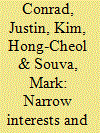

|
|
|
|
|
| Publication |
2013.
|
| Summary/Abstract |
Narrow interests and military resource allocation in autocratic regimes
Why do some autocratic states allocate more resources to the military than others? We contend that as narrow political interests have more influence on a leader, relative to broader political interests, a state's military burden increases. Further, we argue that two domestic factors are central to explaining the relative strength of narrow political interests for military spending, and therefore variation in state military burden. First, institutions that increase the cost of political participation reduce the influence of the median citizen, increasing the strength of narrow political interests and, concomitantly, military spending. Second, as a regime ages, narrow interests become more entrenched and the regime becomes less concerned about overthrow. In turn, older regimes spend more on their militaries. We test hypotheses from this argument by examining the military burden for all autocracies over the period 1950-2000. We find that variation in restrictions on political participation and the age of the regime are central to understanding differences in military spending among autocracies. Further, once these institutional features are taken into account, we find only modest support for the view that certain types of regimes spend more than others. What matters is not regime type but specific institutional features that affect the strength of narrow interests and vary across, and within, autocratic regimes.
|
|
|
|
|
|
|
|
|
|
|
|
|
|
|
|
| 5 |
ID:
124984


|
|
|
|
|
| Publication |
2013.
|
| Summary/Abstract |
In order to explain why successes of economic sanctions predominantly occur in the first two years of a sanction episode, we analyse the dynamic economic and political impact of an economic sanction. Our theoretical analysis of the dynamics of adjustment gives us two important results: firstly, the strongest impact in terms of utility forgone occurs in the initial phase of the sanction episode and, secondly, the long-term gain of compliance decreases during a sanction episode and is lower in the long run than acknowledged by the usual comparative static analysis. On both accounts we expect that sanctions have a higher probability of success in the early phase and a lower probability of success in the long run. Next we build a comprehensive set of vector autoregressive (VAR) models that we apply to the case of a boycott of Iranian oil. An important innovation is that we include both economic and political factors in a VAR model of economic sanctions. Our VAR models find significant impacts of economic sanctions both on key economic variables (government consumption, imports, investment, income) and on two indicators of the political system (the Polity variable that describes shifts in the autocracy-democracy dimension and the Vanhanen Index of Democratization that describes political competition and participation). The impact of an oil boycott on the Iranian economy is considerable: oil and gas rents are important drivers of the Iranian key macroeconomic variables and ultimately of its political system. A reduction of oil and gas rents creates economic costs that act as incentives to move towards a more democratic setting. However, this effect is only significant in the first two years and turns negative after six to seven years, as adjustment of economic structures mitigates the economic and political impact of the sanctions.
|
|
|
|
|
|
|
|
|
|
|
|
|
|
|
|
| 6 |
ID:
124979
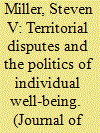

|
|
|
|
|
| Publication |
2013.
|
| Summary/Abstract |
Multiple studies argue that the division of territory between states is a root cause of war in the international system. This is often understood as a function of the unique importance of territory at the level of the individual citizen, because the territory itself directly affects an individual's well-being on multiple dimensions. As such, disputes over territory should also have consequences for an individual's overall subjective appraisal of their well-being. This article argues that disputes over the allocation of territory between states do affect an individual's subjective well-being, but not uniformly. Citizens in states routinely targeted by a territorial threat from a revisionist neighbor are generally unhappy. However, citizens in states that initiate territorial disputes are happier as a result of the aggressive foreign policy of the state leader to secure the coveted territorial good. This is first demonstrated using mixed effects modeling on data drawn from the World Values Survey and Correlates of War Militarized Interstate Dispute dataset. In addition, this article provides an illustration of variations in territorial threat and subjective well-being using the case of Nigeria, finding that Nigerians were happier when their state was initiating territorial threat against its neighbors and less happy during a period when Nigeria itself was the target of territorial threat. The analyses provided advance the territorial conflict research program by measuring the individual-level effects of territorial disputes. In addition, the findings add to a growing scholarship on the political determinants of an individual quality of life, sometimes considered the 'ultimate dependent variable' in social science.
|
|
|
|
|
|
|
|
|
|
|
|
|
|
|
|
| 7 |
ID:
124987
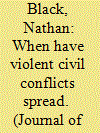

|
|
|
|
|
| Publication |
2013.
|
| Summary/Abstract |
The spread, diffusion, spillover, or contagion of violent civil conflict - including insurgencies, coups, or other internal armed conflict - across international borders is of great concern to civil war scholars and international security policymakers alike. For instance, great power military interventions are often predicated in part on the belief that if a given conflict is not stopped now, it may spread and destabilize an entire region. Nevertheless, our understanding of this phenomenon of 'substate conflict contagion' is hindered by the lack of a comprehensive and accurate universe of cases. In this article I introduce an original dataset of cases and non-cases of substate conflict contagion between 1946 and 2007. The key difference between my dataset and other datasets of this phenomenon is that I require in my definition of contagion not only the spatial and temporal proximity of two conflicts, but also a documented causal link between them. After introducing the dataset and the process by which it was constructed, I show that substate conflict contagion by my definition is significantly less common than previous scholarship and policymaker rhetoric suggest, and that its correlates - and potentially the best methods with which to measure those correlates - are different from prior research as well. Policy implications are considered, and applications of this dataset for future conflict research are explored.
|
|
|
|
|
|
|
|
|
|
|
|
|
|
|
|
|
|
|
|
|